What lens to get for your Nikon D5600?
Released in November 2016, the Nikon D5600 is a consumer SLR that is the successor to the Nikon D5500 and is in every way similar to the latter, except for some minor improvements. We still have a 24MP APS-C sensor without a low-pass filter, an Expeed 4 processor, and an 8.1 cm touch screen and swivel screen. The video mode is also the same, with Full HD at 60 fps. The headphone jack is still not available on this model….
Concerning the improvements, the Nikon D5600 is a little more responsive, it uses the SnapBridge function to automatically transfer photos to a smartphone, it also has a timelapse mode, and finally the handle is slightly more ergonomic.
- 24.2MP DX format CMOS sensor
- Ex peed 4 image processor; approx.; 0.82 x (50 millimeter f/1.4 lens at infinity, 1.0 meter (1))
- 3.2 inches 1.037 meter dot VARI angle touchscreen. Max video clip length: 1920 x 1080: 29 minutes, 59 seconds
That said, it is a great camera that offers good performance and is very pleasant to use, it makes beautiful images and its autonomy is excellent.
If you are looking to improve the quality of your photos and want to see the true potential of your SLR, here is a selection of the best lenses compatible with the Nikon D5600.
This list can help you choose the right tool for your style of photography, whether it’s to take portraits with a beautiful blurred background, spectacular wide-angle photos or macro.
Any ideas to improve this list? Do you disagree on the choice of objectives? Please leave a comment!
Note: Product links in this article lead to Amazon.com
Acronyms and abbreviations to know:
DX: This term means that the lens is optimized for APS-C sensor cameras such as the Nikon D5600, in general, DX lenses are lighter, more compact and less expensive.
FX: term used to describe lenses optimized for 24x36mm full-format full-format SLR cameras (larger than those of APS-C cameras). The names of the FX objectives do not include any mention.
Note: FX lenses are compatible with APS-C sensor cameras! but you have to multiply by 1.5 to know the equivalent focal length. For example, the Nikon AF-S 50 mm f/1.8G I’m talking about in this article is equivalent to a 75mm focal length when used on a Nikon D5600.
AF-S (AutoFocus SWM): means that the lens is equipped with a SWM (Silent Wave Motor) motor that provides fast, accurate and near-quiet autofocus. Most Nikon lenses now use this technology and therefore most include the AF-S name in their names.
AF-P (AutoFocus Pulse): a new stepping motor technology that is optimized for video: focusing is smooth, smooth and quiet.
G: means that the lens does not have an aperture adjustment ring. The aperture selection is only made from the camera via the body dial. This is the case for most recent objectives.
ED: means that the lens has a lens with a low light dispersion glass type, which corrects chromatic aberrations (defects in the image) and provides better contrast and superior color correction.
VR (Vibration Reduction): means that the lens incorporates an optical image stabilizer that helps to reduce vibration, and thus avoid motion blur when using your handheld SLR.
DC: it is the equivalent of the DX range but at Sigma. Sigma DC lenses are optimized for APS-C sensor SLRs.
HSM (Hyper Sonic Motor): a Sigma motorization system that ensures fast and quiet focusing.
OS (Optical Stabilizer): an anti-vibration system from Sigma that reduces camera shake.
DG: Sigma’s DG lenses are suitable for both full-format SLR and APS-C cameras.
EX: represents the professional range of Sigma lenses, which offer superior performance in terms of image quality and construction.
Summary
- Nikon AF-S 50 mm f/1.8G
- Nikon AF-S DX 35 mm f/1.8G
- Nikon AF-S DX 55-300 mm f/4,5-5,6 ED VR série G
- Sigma 10-20 mm F3.5 EX DC HSM
- Sigma 17-50 mm F2,8 DC EX OS HSM
- Sigma 105 mm f/2.8 DG OS HSM
- Comparative Table
- Useful accessories
- Links
Nikon AF-S 50 mm f/1.8G
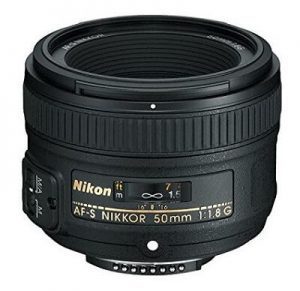 Weight: 187 g
Weight: 187 g
Filter size: 58 mm
Designed for use on full-format FX cameras, this 50mm f/1.8 is also compatible with APS-C sensor cameras such as the Nikon D5600, which produces a 75mm focal length, which is ideal for portrait photography. Don’t worry, we won’t lose any image quality at all! It is one of the best objectives of this selection in terms of sharpness, but also one of the lightest and cheapest.
Its f/1.8 aperture provides a very nice background blur that gives a professional look to your photos. It is very suitable in low light situations (wedding, concert…).
If you are an amateur photographer or a complete beginner, this 50mm f/1.8 is to be tried urgently on your Nikon D5600.
_
Nikon AF-S DX 35 mm f/1.8G
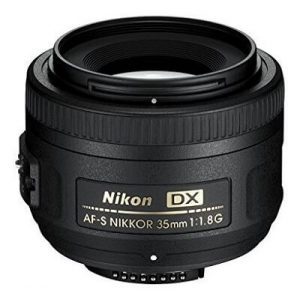 Weight: 200 g
Weight: 200 g
Filter size: 52 mm
If you were to buy only one lens for your Nikon D5600, opt for the 35mm f/1.8 ! It is a fixed focal length, so you can’t zoom in/out and you’ll have to work on the framing a little bit, but unlike a basic lens like the 18-55mm, the images obtained with this 35mm are much sharper.
Its f/1.8 aperture provides a very pleasant background blur, but also allows you to take pictures even in low-light conditions. Compact and lightweight, its autofocus system is quiet and fast, and it is sold at a very attractive price. The only downside is that it doesn’t have an integrated image stabilizer, which can be annoying if you want to make video.
In short, it is an excellent value for money for D5600 owners.
_
Nikon AF-S DX 55-300 mm f/4.5-5.6 ED VR G
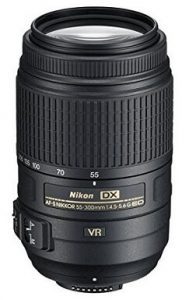 Weight: 580 g
Weight: 580 g
Filter size: 58 mm
A very practical lens to complete the 18-55mm: it allows you to zoom up to 300mm to get closer to the subject of the picture but it is also suitable for portrait photography. Stabilized and silent, it is a very good zoom for beginners who would like to take distant shots (safaris, sporting events…).
Beware of Sigma and Tamron zooms at low prices, most of them don’t have a vibration reduction system! This is an important point to take into account to avoid missing every other photo, so choose Nikon directly if you want to avoid disappointments!
Nikon also sells a 55-200 mm, lighter and at a price almost half as expensive as this 55-300mm.
_
Sigma 10-20 mm f/3.5 EX DC HSM
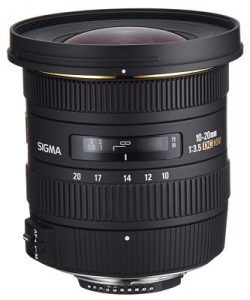 Weight: 520 g
Weight: 520 g
Filter size: 82 mm
A very good wide-angle lens that allows you to take quite impressive pictures. Rather compact and well finished, its autofocus is fast and it delivers very sharp images, even if there is a little distortion visible at 10mm. The fixed aperture of f/3.5 also allows you to take pictures where the brightness is not very good or where flashes are prohibited.
It is also one of the cheapest wide angles for Nikon APS-C cameras and is supplied with a protective pouch and sun visor.
If you want to take pictures of landscapes, architecture or interiors, that’s the right thing to do.
_
Sigma 17-50 mm f/2.8 DC EX OS HSM
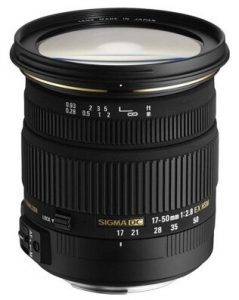 Weight: 570 g
Weight: 570 g
Filter size: 77 mm
This 17-50mm from Sigma is an all-in-one lens for those who don’t want to bother with multiple lenses. Its sharpness is much better than the 18-55mm sold as a kit with the Nikon D5600, and even if it zooms a little less its focal range allows you to take landscape and portrait photos.
The fixed aperture of f/2.8 over the entire focal range allows you to take pictures even in low light conditions, and also offers a pleasant bokeh. It is also very quiet and its autofocus is fast and very accurate. A downside however, its weight of 570g is still quite heavy, but it is the compromise to be made to benefit from a versatile zoom with a constant (and stabilized!) aperture.
Be careful, when you buy the Sigma 17-50mm on Amazon.fr select the Nikon mount (Amazon offers the choice between Sony mount, Canon…).
_
Sigma 105 mm f/2.8 DG OS HSM
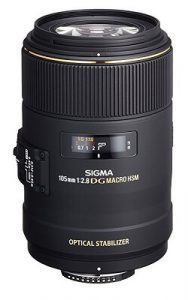 Weight: 725 g
Weight: 725 g
Filter size: 62 mm
The lens to have if you want to take beautiful macro photos (insects, cooking…) but also beautiful portraits. It works on both full-format and APS-C cameras, so you can keep it if you decide to switch to full-format. On a Nikon D5600, this Sigma 105mm f/2.8 gives a focal length equivalent to 160mm. Its minimum focusing distance is 31cm.
Its constant aperture of f/2.8 allows to have a clean and harmonious background blur (or “bokeh”). A big positive point, its highly effective Sigma OS stabilizer is extremely practical for the macro. Its weight is quite heavy, but if you want outstanding image quality to make macro with your Nikon D5600, it’s the best of the best.
Nikon also offers a very good 40mm f/2.8, but which requires to get very close to the subject, and which does not have an optical stabilizer (it is more annoying!). This Sigma 105mm f/2.8 is therefore the ideal option for serious macro photography.
_
COMPARATIVE TABLE
All of the Nikon D5600 compatible lenses mentioned above are included in this comparison chart to help you choose the right equipment. You will be able to compare them according to their price, the weight and the utility of each one to choose which will suit your budget and your style of photo.
| Lens | Price | Weight | Aperture | Utility |
|---|---|---|---|---|
| Nikon 50 mm f/1.8G AF-S | $$$$$ | 187 g | f/1.8 | portrait |
| Nikon 35 mm f/1.8G AF-S DX | $$$$$ | 200 g | f/1.8 | landscape / street photography |
| Sigma 10-20 mm f/3.5 EX DC HSM | $$$$$ | 520 g | f/3.5 | wide angle (architecture, landscape) |
| Sigma 17-50 mm f/2.8 DC EX OS HSM | $$$$$ | 465 g | f/2.8-4 | all-in-one (travel) |
| Nikon 55-300 mm f/4,5-5,6 AF-S DX ED VR G | $$$$$ | 335 g | f/4-5.6 | zoom |
| Sigma 105 mm f/2.8 DG OS HSM | $$$$$ | 725 g | f/2.8 | macro (insects, flowers…) |
_
USEFUL ACCESSORIES
A small selection of useful accessories to have in addition to your lenses and your Nikon D5600:
LINKS
- All the lenses of the DX series on Nikon USA
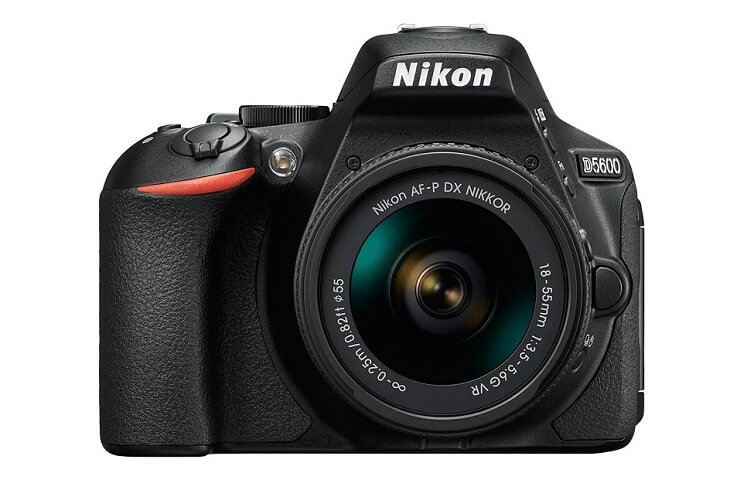

The 50mm 1.8 G needs an AF-Motor in the camera body. It will only work in manual focus with the d5600.